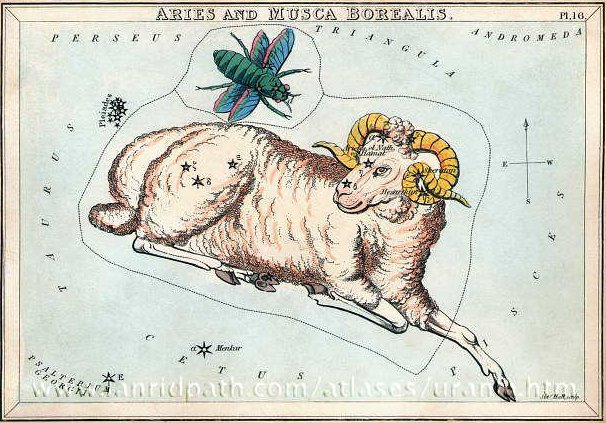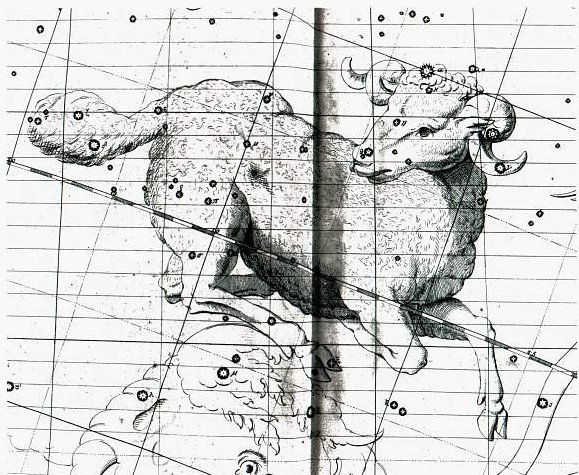2. In Urania's Mirror Aries is depicted as a ram lying down, and the pair of curved horns could illustrate the end of the Moon season:
It is rather evident that the darkly coloured Fly above (which looks like a horse-fly, takaure) should correspond to the manu rere (living spirit) of the returning Sun: ... From a religious point of view, the high regard for flies, whose increase or reduction causes a similar increase or reduction in the size of the human population, is interesting, even more so because swarms of flies are often a real nuisance on Easter Island, something most visitors have commented on in vivid language. The explanation seems to be that there is a parallel relationship between flies and human souls, in this case, the souls of the unborn. There is a widespread belief throughout Polynesia that insects are the embodiment of numinous beings, such as gods or the spirits of the dead, and this concept extends into Southeast Asia, where insects are seen as the embodiment of the soul ... Furthermore, the Pleiades (Mata-riki) at her back are like the small offspring 'eyes' (periods) of the coming year: ... Among the Nahyssan of S. Carolina time was measured and a rude chronology arranged by means of strings of leather with knots of various colour, like the Peruvian quipos. The Dakota use a circle as the symbol of time, a smaller one for a year and a larger one for a longer period: the circles are arranged in rows, thus: OOO or O-O-O ... The Ram is a female we can see from her outstretched left front leg. It should be mentioned en passent that there is another Fly constellation (the southern fly, Musca Australis), conceived of much later and located close to the southern pole:
Flamsteed avoided the idea of reincarnation brought about by a black spirit fly from heaven:
In Gb7-26, a Sun-day, the black great fish could be a 'reincarnation' of the Babylonian Tiamat, which once ruled the opposite side of the sky compared to the Lion King. She should have swallowed Sun in the eveing and returned him in the morning (or in autumn respectively spring). The 'cap' inside the fish presumably represents the sky roof above, a sign of Sun. From this 'cap' (in the past, at left) time moves on to the next generation, to the offspring (hua), as when the dry old skull of a dead chief generates many eggs: ... Up to the present time, fertility spells for fowls have played an important role. Especially effective were the so-called 'chicken skulls' (puoko moa) - that is, the skulls of dead chiefs, often marked by incisions, that were considered a source of mana. Their task is explained as follows: 'The skulls of the chiefs are for the chicken, so that thousands may be born' (te puoko ariki mo te moa, mo topa o te piere) ...As long as the source of mana is kept in the house, the hens are impregnated (he rei te moa i te uha), they lay eggs (he ne'ine'i te uha i te mamari), and the chicks are hatched (he topa te maanga). After a period of time, the beneficial skull has to be removed, because otherwise the hens become exhausted from laying eggs ... The Belly of the Whale (Baten Kaitos) is rising immediately before Segin and Mesarthim. At the proper time of the year this mythic sea-monster was moving up from the deep like a great turtle intent on laying her eggs on the beach. |




